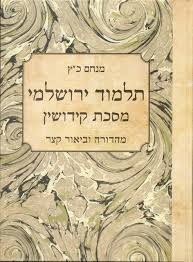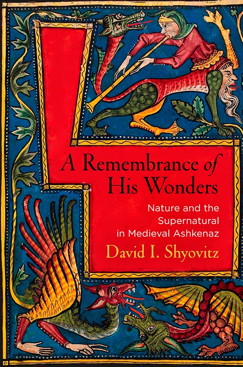1. When we relaunched The Talmud Blog, back in 2011, I set a Google reminder for the word “Talmud.” After all, we claimed to provide “Talmudic news, reviews, currents and criticism,” and what better way to stay current than with handy email reminders from the indexers of the Internet. At the time, the Internet was a simpler place, or at least so it seemed. We may have had our suspicions of the influence of Facebook and ad tech on our lives, but certainly not to the extent that we do now. Rather quickly, however, I discovered that my expectations of the Google alert were rather naïve: the vast majority of the material on Talmud that Google dredged up for me in daily emails could best be described as anti-Semitic drivel. Continue reading
Ophir and Rosen-Zvi’s “Goy”
Adi Ophir and Ishay Rosen-Zvi, Goy: Israel’s Multiple Others and the Birth of the Gentile (Oxford University Press, 2018)
Review by Mira Balberg
In Erica Jong’s novel Fear of Flying, the protagonist Isadora Wing relates her flirtatious conversation with the British charmer Dr. Adrian Goodlove, in which he complains about the fact that only Jews are allowed to make jokes about Jews (a complaint to be famously repeated decades later in Seinfeld). “Why should I be deprived of the pleasure of masochistic Jewish humor just because I’m a goy?” he asks. Isadora then comments to herself: “He sounded so goyish saying goy.”
On ed. Katz of Yerushalmi Qiddushin

Menachem Katz, Jerusalem Talmud: Tractate Qiddushin, critical edition and short explanation (Jerusalem: Yad Ben Zvi and Schechter Institute of Jewish Studies, 2015)
Amit Gvaryahu in conversation with Yedidah Koren*
Menahem Katz’ edition of Yerushalmi Qiddushin is incredibly useful. It presents the entire tractate divided into sugyot and subsections and a punctuated text and layed out line by line. Katz adds a short commentary, references to parallels, quotes in medieval compendia and commentaries, and collects all the variants. In short, it is a wonderful tool and highlights what is sorely lacking for the rest of Yerushalmi. Continue reading
Weiss and Stav’s “The Return of the Missing Father”
Haim Weiss and Shira Stav, The Return of the Missing Father: A New Reading of a Chain of Stories from the Babylonian Talmud (Jerusalem: Bialik Institute, 2018) – Review by Mira Balberg
“Talmudic stories are amazing!” I promised a class of fifteen college freshman who, two years ago, took a seminar with me on the cultural history of marriage. By this point in the course we had already read Jane Austen’s Pride and Prejudice, Murasaki Shikibu’s The Tale of Genji, Henrik Ibsen’s A Doll House, and other world-class masterpieces: I was finally about to introduce them to my little corner of the world and read with them stories about marriage from the Babylonian Talmud. It was only natural to pick the seven stories in Kettubot 62b-63a, which all relate to the tension between marriage and family life on the one hand, and the study of Torah (which usually involves long absences from home) on the other hand. But the group of students – all brilliant and highly enthusiastic students hand-picked for an honors program in the Humanities – were not impressed. The discussion, which has normally been lively and exciting, was languid and the students’ comments were predictable and trite. When I pressed, one courageous student said: “I don’t really know what there is to say about these stories. They are so… short.” And another said: “I just feel like I got it after the first story. It’s good to study Torah but don’t neglect your wife. That the message, right?” Continue reading
Prof. Yaakov Elman Z”L, 1943-2018
I just received the terrible news that Professor Yaakov Elman has passed away. The following funeral details have been sent by Professor Shalom Carmy: Monday, July 30th, 12:30pm at Kehilla Chapels, 60 Brighton 11th Street Brooklyn (click here for directions). Continue reading
David Shyovitz’s “A Remembrance of His Wonders”
David Shyovitz, A Remembrance of His Wonders: Nature and the Supernatural in Medieval Ashkenaz, reviewed by Miri Fenton

After reading David Shyovitz’s excellent article on werewolves, and attending his lecture at the World Congress of Jewish Studies in Jerusalem this summer, I was very excited to read his first book. In A Remembrance of His Wonders: Nature and the Supernatural in Medieval Ashkenaz, published earlier this year by the University of Pennsylvania Press, Shyovitz combines creative philosophical thinking and close textual reading to write a new and engaging intellectual history of medieval Ashkenaz.
It Functions, and that’s (almost) All: Another Look at “Tagging the Talmud”
Itay Marienberg-Milikowsky is currently a visiting scholar at the Interdisciplinary Center for Narratology, Universität Hamburg, where he conducts his post-doc research entitled “The Rise of Narrativity in Talmudic Literature: Computational Perspectives.” This is our third post in an ongoing series on Digital Humanities and Rabbinic Literature.
In Alfred Döblin’s famous novel Berlin, Alexanderplatz, a certain Franz Biberkopf rejoins the modern city after a prolonged incarceration, where he is astonished by the relentless, alienating pace of change. In time, Biberkopf gradually becomes entrapped in a net of forces stronger than himself, and his bewilderment is reflected in the splitting of his voice – or, maybe, the narrator’s voice – into two (if not more) contradictory points of view. Thus, the telegraph is described in one sentence as “astonishing, clever, tricky,” while in a subsequent sentence, we read: “It’s hard to get enthusiastic about all this; it functions, and that’s all” (p. 76). Continue reading
The Constitution as a Page of Talmud
Reading the news every morning (and afternoon, evening, etc.) is depressing. Continue reading

Natural Language Processing of Rabbinic Texts: Contexts, Challenges, Opportunities
The Talmud Blog is happy to continue our series on the interface of Digital Humanities and the study of Rabbinic Literature with a post by Marton Ribary of University of Manchester.
I read Michael Satlow’s enthusiastic report on the Classical Philology Goes Digital Workshop with great pleasure. I am delighted to see how the study of Rabbinic literature moves towards the use of digital tools and especially Natural Language Processing (NLP) methods. Below I shall sketch the background of NLP methods applied to Rabbinic literature and what we can learn from projects concentrating on other classical linguistic data, notably Latin. I shall briefly discuss the enormous obstacles Rabbinic literature poses even compared to Latin, which means that our expectations to achieve meaningful results in standard 3-5 year research projects should be very moderate. Nevertheless, I shall argue that we should dream big and aim for courageous projects accompanied by an outward-looking strategy in order to attract big corporate money. Continue reading

Digital Humanities and Rabbinic Literature
The Talmud Blog is happy to be hosting a series on the interface of Digital Humanities and the study of Rabbinic Literature. Our first post comes from Prof. Michael Satlow, of Brown University.
The other week I attended a workshop called Classical Philology Goes Digital Workshop in Potsdam, Germany. The major goal of the workshop, which was also tied to the Humboldt Chair of Digital Humanities, was to further the work of creating and analyzing open texts of the “classics”, broadly construed. We have been thinking about adding natural language processing (including morphological and syntactic tagging – or, as I learned at the workshop, more accurately “annotation”) to the Inscriptions of Israel/Palestine project. While we learned much and are better positioned to add this functionality, I was most struck by how far the world of “digital classical philology,” focused mainly on texts, has progressed, and it got me thinking about the state of our own field. Continue reading
